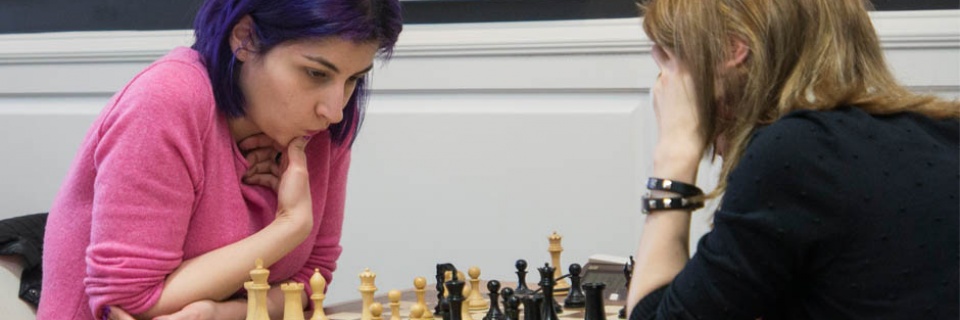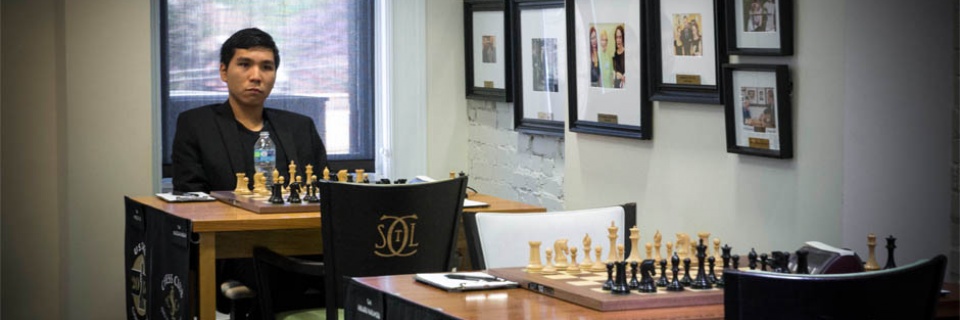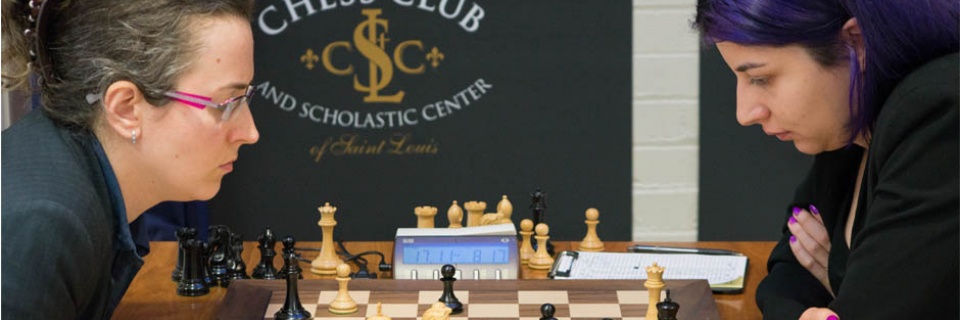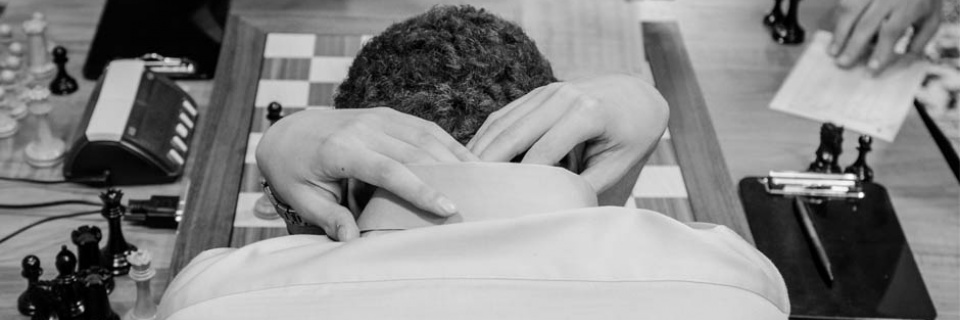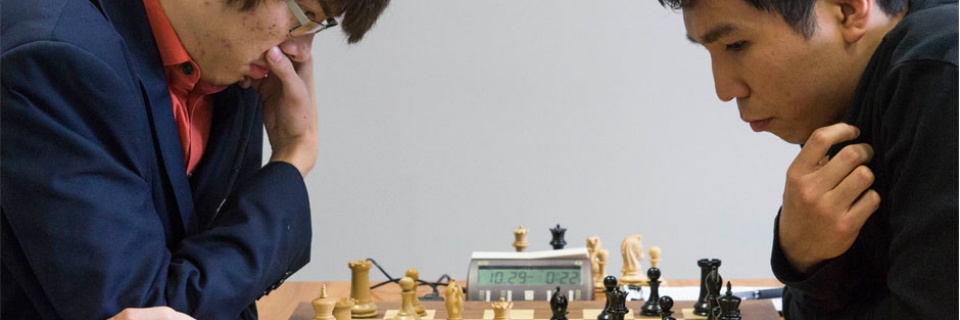2012 U.S. Championships News
GM Hikaru Nakamura kept his half-point lead of the U.S. Chess Championship by holding the pursuing GM Ray Robson to a draw Saturday afternoon. // Lennart Ootes photo
The stage is set for a thrilling Sunday finale in the 2015 U.S. Chess Championships. In Saturday’s penultimate round, neither leader GM Hikaru Nakamura no GM Ray Robson, who trails by a half point, took any risks in their game before agreeing to a draw on the 30thmove. This gave GM Alexander Onischuk the chance to step within striking distance, after his convincing defeat of GM Sam Sevian. The results leave Nakamura (7/10) in the clear lead and headed for a clash with Onischuk on Sunday, while Robson (6.5/10) hopes to catch pace taking black against GM Timur Gareev. Though no longer in contention for the U.S. title, GM Wesley So recovered nicely from his forfeit on Friday and won a model game against 2014 U.S. Champion GM Gata Kamsky.
2015 U.S. Chess Championships Standings after Round 10
Saturday’s Round 10 of the 2015 U.S. Women’s Chess Championship couldn’t have gone better for GM Irina Krush, who scored her fourth consecutive victory with a defeat of WFM Jennifer Yu, while co-leader WGM Katerina Nemcova lost her first game of the tournament at the hands of IM Nazí Paikidze. Now after trailing for nearly the entire tournament, Krush (8/10) finds herself in clear first with a full-point lead over both Nemcova and Paikidze (7/10). Krush will take White against Nemcova in Sunday’s finale, while Paikidze takes White versus WGM Sabina Foisor. A tie for the lead in either Championship after Sunday will lead to an Armageddon playoff on Monday afternoon.
2015 U.S. Women's Chess Championships Standings after Round 10
Robson and Nakamura played a relatively tepid game in the Four Knights Scotch. After a few exchanges and some maneuvering it was clear that neither player would be able to create any serious winning chances. With Nakamura having White against Onischuk in the final round, the U.S. Championship is still his to win.
“I’m leading the tournament, and I’m White, so certainly I like my chances,” Nakamura said. “I’ll try to do something fairly simple and not lose my mind.”
Robson, being a half-point behind, was expectedly more ambitious in his plans for tomorrow: “For me to try to get first, I probably have to win. If I can get some chances, then anything is possible.”
Veteran World Top 100 GM Alex Onischuk has much to smile about, entering Sunday's final round with chances for the 2015 U.S. title. // Lennart Ootes photo
The draw on the top board meant Onischuk, who has stayed relatively quiet thus far, is suddenly in direct contention for the title. Facing GM Sam Sevian’s Grunfeld Defense on Saturday, Onischuk went for a complex line and forced an exchange of queens. Pushed into a slightly worse endgame, Sevian was unable to put up much resistance and lost the thread quickly.
Onischuk has his work cut out for him on Sunday, being a full-point behind Nakamura and forced to play for the win if his intentions are to fight for the U.S. title. Making the matchup even more intriguing is, out of six classical encounters between the two, Onischuk holds the advantage with one win and five draws.
“Of course I am playing Black tomorrow and Hikaru is a huge favorite, but if I was told before the tournament that I would be in this situation, I would think that I’m having a good tournament,” Onischuk said.
GM Alex Onischuk vs. GM Sam Sevian Annotations by GM Josh Friedel
GM Wesley So bounced back from his black Friday at the 2015 U.S. Chess Championship with an outstanding win over reigning champion GM Gata Kamsky. // Austin Fuller photo
Closely watched was how GM Wesley So would rebound from his shocking forfeit on Friday for his match against reigning champion Kamsky on Saturday. To the delight of spectators worldwide, So played nearly flawless.
“I just wanted to get a position where I can keep on playing, regardless of color,” So said. “I played an early h6 to get the bishop pair and try to slightly imbalance the position. He probably pushed too hard and made some mistakes starting with 20.h4 I think.”
As So proved during the game, Kamsky’s early kingside activity was just an illusion. After the strong 22…Qe4, Kamsky began shaking his head in frustration, as So had already begun to take over the initiative. In order to get his knight back into the game, Kamsky was forced to give up a pawn -- which So grabbed and never looked back, converting the victory in style.
GM Gata Kamsky vs. GM Wesley So Annotations by GM Josh Friedel
Though the other games of the day had no bearing on the top standings, they were no less interesting. GM Conrad Holt and GM Sam Shankland duked it out in the sharp anti-Moscow Gambit of the Semi-Slav Defense. Despite being low on time, Holt launched a furious attack with 23.f4, prompting Sam to give up his queen for two rooks in order to ease the pressure. Messy complications followed, and Holt eventually emerged on top thanks to his powerful queen.
Also sacrificing a pawn in the opening was GM Varuzhan Akobian, who gained long-term compensation against GM Daniel Naroditsky by sacrificing an exchange to boost his attack. Naroditsky failed to find the best defense, but did find himself getting mated just before the first time control. GM Kayden Troff and GM Timur Gareev had no intentions of playing it safe either and, after a prolonged battle, they drew in an equal queen endgame.
Reigning Women’s Champion GM Irina Krush finally claimed a clear lead in the 2015 U.S. Women’s Chess Championship, but only by winning her fourth game in a row – on Saturday over WFM Jennifer Yu. Krush played solidly on the Black side of an English Opening, first equalizing before taking advantage of Yu’s mistakes for a decisive kingside attack.
Yu could have avoided her fate with 32.h3, taking control of some key squares, but instead played 32.b5 and allowed 32…g5! Ushering Krush’s rook to h6 to deliver checkmate.
IM Nazi Paikidze took down tournament leader WGM Katerina Nemcova in Round 10, now just a point out of first place. // Kevin Duggin photo
Nemcova definitely had chances to win against Paikidze but faltered with 26.Bxc6, giving away most of her advantage.
“I got into time trouble, and I had some difficulties,” Nemcova said. “Taking on c6 looked nice but wasn’t so good.”
Paikidze, the only undefeated woman left in the field, played solidly and seized the opportunity to play 32…Qe1 with a devastating threat of Bf2. Nemcova followed with a blunder of 33.Nd6, as after 33…Ne5 the threat of Bf2 was no longer stoppable. Nemcova was only able to give a few spite checks before being forced to resign.
“Coming to the game today, I was just hoping I would equalize in the opening,” Paikidze said. “Only when I played 32…Qe1, I realized I could win this game.”
WGM Katerina Nemcova vs. IM Nazi Paikidze Annotations by GM Josh Friedel
WGM Tatev Abrahamyan built an advantage and worked through an excellent endgame against IM Rusudan Goletiani in Round 10. // Lennart Ootes photo
In one of the sharpest games of the tournament, WGM Tatev Abrahamyan launched a direct kingside attack against IM Rusudan Goletiani. The invasion led Goletiani to sacrifice a pawn with 21…h5 in order to defend, though it allowed Abrahamyan to simply pile up on the g-file to break through. After a series of complications and a few missed wins for White, the players found themselves in a complex rook endgame, which was nicely converted by Tatev.
WGM Tatev Abrahamyan vs. IM Rusudan Goletiani Annotations by GM Josh Friedel
The final round of the 2015 U.S. Chess Championships is set for Sunday at 1:00 p.m. CDT. Tune in to www.uschesschamps.com/live for play-by-play commentary by GM Yasser Seirawan, WGM Jennifer Shahade and GM Maurice Ashley.
World Top 10 GM Wesley So learned a FIDE rule the hard way Friday afternoon, after being forfeitted for improper notation on his scoresheet. // Lennart Ootes photo
By FM Kostya Kavutskiy
Sadly, a great day of chess in the U.S. Championship was marred by an unfortunate incident that happened within the first hour of play on Friday. GM Wesley So was forfeited after his sixth move against GM Varuzhan Akobian, for writing personal notes on a separate sheet of paper during their encounter.
According to Chief Arbiter Tony Rich, Wesley was writing words of “general encouragement and advice” to himself on a piece of paper below his score sheet – a detail forbidden per the laws of FIDE. Later revealed was that So had been given two prior warnings for the infraction in earlier rounds, and Friday came as So’s third offense.
“I mentioned to Wesley twice earlier in the event that using notes or other sources of information is not allowed and strictly forbidden, according to the FIDE laws of chess," Rich said. "After the second warning, I notified Wesley that, if it happened again, I would be required to forfeit him. Unfortunately, that was the decision that I had to make: Wesley's round 9 game was forfeited.”
The incident sparked a heated discussion over Twitter with many chess players, journalists, organizers and arbiters weighing in to debate the merits of the decision. One thing was clear—this was an incredibly regrettable occurrence that blemished an otherwise fantastic tournament.
While the distraction was serious, the rest of the players in the U.S. Chess Championships were still in the middle of a crucial ninth round, and produced some fascinating chess. Tournament leader GM Hikaru Nakamura was a bit lucky to draw with GM Timur Gareev, though his main rival in the Championship race, GM Ray Robson, couldn’t find a win either, in a long game against GM Sam Sevian.
The results left Robson (6/9) still a half-point behind Nakamura (6.5/9) – with the two set to face off Saturday in a critical Round 10 matchup.
In the women’s section, leader WGM Katerina Nemcova was unable to produce a decisive result with the Black pieces against WIM Viktorija Ni, allowing GM Irina Krush to finally catch pace with her win over WGM Tatev Abrahamyan in a queen and minor piece endgame.
Veteran World Top-10 GM Hikaru Nakamura has led the 2015 U.S. Championships since Round 1. // Lennart Ootes photo
Not even Nakamura could expect that his 1.Nf3 would be answered with 1…b6?! from the consistently unpredictable GM Timur Gareev. Seizing the opportunity to grab space with 2.e4 and 4.d4, Nakamura followed with a controversial pawn sacrifice that didn’t seem to offer enough compensation. Later regretting his decision, Nakamura said: “I should have known better, I’ve played this e6-b6 probably 500 times on ICC, frankly.”
After grabbing the pawn and developing comfortably, Gareev then captured a second pawn with 20…Qxc3, allowing Nakamura to force repetition by repeatedly attacking Black’s queen with his bishop – and letting him off the hook after the dubious pawn sacrifice.
“I suspect, perhaps, my rating saved me today,” said Nakamura, realizing his fortune. “When you’re the top seed, I think your opponents tend to overestimate the position I have over their own position.”
Asked about his decisive pairing against Robson on Saturday, Nakamura said: “The onus isn’t on me to do anything special -- I just have to keep the lead.”
GM Ray Robson trails leader Hikaru Nakamura by a half point, with the two set to play in a pivotal Round 10 on Saturday. // Austin Fuller photo
Trailing Nakamura by a half point entering round nine, it was clear Robson needed to take some risk in order to defeat Sevian on Friday. With these intentions, Robson chose the Scheveningen Sicilian, inviting Sevian to play the aggressive Keres Attack with 6.g4 -- an invitation that Sam promptly accepted.
“I didn’t want to come under a huge attack on my king,” Robson said. “I was kind of worried early on when [Sevian] started playing 6.g4, 7.h3 and 8.f4, but somehow I managed to avoid it.”
In a tense middlegame, the two players played out a typical Najdorf structure with the kings castled on opposite sides of the board. After a few exchanges, Sevian was left with the better dark-squared bishop, but Robson had full control over the open e-file. Neither player could get an edge in the eventual time scramble, leading to simplification and a drawn rook-and-bishop endgame.
After the game Robson confessed his intentions for Saturday’s critical game against Nakamura: “I’m not going to do anything crazy because, even if we draw, we still have one more round to play. I’ll still have chances.”
GM Sam Sevian vs. GM Ray Robson Annotations by GM Josh Friedel
Reigning U.S. Champion GM Gata Kamsky essayed his beloved London System against GM Kayden Troff, who responded with a classical Fianchetto Setup. After both sides completed their development, Troff initiated complications with 17…cxd4 18.exd4 e5, leading to a series of exchanges that left him with a strong passed pawn on d4. Kamsky soon erred and was forced to give up a rook in exchange for the d4 pawn and one of Troff’s bishops. Despite being up the exchange, however, Troff was unable to convert and the players drew on the 41st move.
GM Gata Kamsky vs. GM Kayden Troff Annotations by GM Josh Friedel
Other results of Round 9 included GM Daniel Naroditsky’s first win of the event, finding a way to aesthetically crack GM Conrad Holt’s Winawer French Defense. GM Sam Shankland and GM Alexander Onischuk played 24 moves of theory to reach a difficult endgame, though Shankland was unable to utilize a slight material advantage and liquidated into a drawn rook-and-pawn endgame.
GM Irina Krush collected a win over WGM Tatev Abrahamyan in Round 9 and took a share of the lead for the 2015 U.S. Women's Championship. // Lennart Ootes photo
Though eventually earning the full point, Krush did not get much out of the opening against Abrahamyan. After several minor pieces were exchanged, Krush was left with a knight and a bit more space against Black’s bishop, with all of the major pieces still left on the board. Abrahamyan then placed a lot of pressure against White’s c-pawn, leading to a rook exchange and a simplified position.
With a queen and bishop against Krush’s queen and knight, Abrahamyan blundered with 34…b3, allowing a deadly attack against her king. Mate was inevitable by 40. Qh5.
GM Irina Krush vs. WGM Tatev Abrahamyan Annotations by GM Josh Friedel
WIM Viktorija Ni was able to hold leader WGM Katerina Nemcova to a draw in Round 9, allowing GM Irina Krush to catch pace atop the standings. // Austin Fuller photo
Hoping to keep the lead was Nemcova, who could not win against Ni in a complex English.
“I thought I was better after 20…Bh3, but I just misplayed it,” Nemcova said. “Maybe 22…f5 was too soon.”
Indeed, despite holding the advantage in the middlegame, Nemcova could not improve her position, with a rook trade leading to perpetual check and the draw. Nemcova has a tough finish to her tournament, set to play IM Nazí Paikidze in Saturday’s Round 10 and Krush in the final round.
“Tomorrow I have White, so I’m playing for a win,” Nemcova said. “Both of the rounds will be really tough.”
WIM Viktorija Ni vs. WGM Katerina Nemcova Annotations by GM Josh Friedel
Paikidze (6/9) stays within range of the front with her win today against WFM Jennifer Yu. In the 4.e3 variation of the Slav Defense, Paikidze sacrificed two pawns in exchange for a powerful center and good piece activity. Yu went down quickly, losing a piece by move 20 before resigning on the 36th move.
The final two rounds of the U.S. Chess Championships feature several critical matchups to the U.S. Championship races, beginning Saturday with Robson vs. Nakamura and Nemcova vs. Paikidze. Tune into www.uschesschamps.com at 1:00 p.m. CDT to follow play-by-play commentary by GM Yasser Seirawan, WGM Jennifer Shahade and GM Maurice Ashley.
Things are looking up for GM Hikaru Nakamura, who regained sole possession of first with his Round 8 win over GM Kayden Troff. // Lennart Ootes photo
Thursday’s eighth round was an important day for the standings of the 2015 U.S. Chess Championships, with GM Hikaru Nakamura (6/8) taking clear first after his win over GM Kayden Troff. GM Ray Robson, who shared the lead with Nakamura entering the day, was unable to create any winning chances for himself and dropped into second place after his draw with GM Sam Shankland. Meanwhile GM Wesley So flew too close to the sun yet again, losing his third game of the tournament after sacrificing a piece in the opening against a well-prepared GM Conrad Holt.
2015 U.S. Chess Championship Standings
In the Women’s Championship, WGM Katerina Nemcova (6.5/8) could not pose any problems for WGM Sabina Foisor, falling worse at one point before finding her way to a draw. The half-point allowed reigning Women’s champion GM Irina Krush to close the gap, with her victory over FM Alisa Melekhina pulling her within a half-point of the lead.
2015 U.S. Women’s Chess Championship Standings
Reigning U.S. Junior Champion GM Kayden Troff was turning in a fine U.S. Championship, though ran into a Nakamura buzzsaw in Round 8. // Austin Fuller photo
Sticking with his strategy of playing for a win with both colors, Nakamura chose the risky Benoni Defense against Troff, bringing a fight for control over critical kingside squares. Nakamura’s novelty 14…g5 was quite interesting, taking control of the f4-square while giving up f5.
“I got exactly what I wanted,” Nakamura said. “I think I was simply better, and then I started playing a lot of mickey-mouse type moves -- being an idiot for no reason.”
Specifically, Nakamura stated unhappiness with 17…g4, later preferring 17…Qg7 instead, correctly showing that, if Troff had found 21.Re2, then White would have stood better.
In the post-game interview with GM Maurice Ashley, Nakamura was especially critical of his own play, indicating that he is somewhat lucky to be winning so many games: “Well I wouldn’t have the score I have if I was playing against certain other players, let me put it that way.”
GM Kayden Troff vs. GM Hikaru Nakamura Annotations by GM Josh Friedel
Shankland surprised Robson with the French Defense, obtaining seemingly promising attacking chances on the queenside against Robson’s king. However he couldn’t find a way to break through and, after a series of trades, agreed to a draw in an equal queen-and-pawn endgame.
“I went into this game looking for a fight,” said the always ambitious Shankland. “Ray is leading the tournament. I got a sharp-ish position, but he was just too solid.”
Now trailing Nakamura by a half-point, Robson weighed realistic chances for the title.
“I still think it’s [Nakamura’s] tournament,” Robson said. “I’m going to play him [Saturday, Round 10], so if I want to win, that game’s going to be very important.”
GM Wesley So’s chances at his first American title look dim after his third loss of the tournament, on Thursday to GM Conrad Holt. In the ever-popular Russian System against the Grunfeld Defense (5.Qb3), Wesley found himself caught in some home preparation by Holt, eventually forced to sacrifice an exchange for two pawns and dynamic play. While the silicon beast thought So had enough compensation, he wasn’t able to prove it over the board, erring with 20…b5 and dropping another pawn. The 2014 U.S. Open Champion Holt had few problems converting his decisive material advantage.
GM Timur Gareev earned his first victory with a convincing win over GM Sam Shankland in Round 8. // Lennart Ootes photo
Finally scoring his first win of the tournament was GM Timur Gareev, who went all-out against GM Sam Sevian—sacrificing his b2-pawn in the sharp Trompowsky Attack in order to get a lead in development.
“The way I built up the game was pretty adventurous, but not really solid,” Gareev said. “I was playing in the spirit of the gambit.”
In particular, the advance 15.e5 followed by 16.d6! -- a sacrifice of two more pawns to blow up the position -- was quite favorable for Gareev, who fully activated his pieces and launched a catastrophic attack.
“I think 20.f5 was the last move that takes away all the chances from him,” Gareev said.
GM Timur Gareev vs. GM Sam Sevian Annotations by GM Josh Friedel
GM Irina Krush has moved within a half point of the lead with her win over FM Alisa Melekhina on Thursday. // Austin Fuller photo
In the women’s section, WGM Katerina Nemcova finally slowed down as she failed to put any pressure on Foisor, trading queens early to reach an equal endgame. After the game Nemcova seemed unfazed, and maintained that her last-round pairing with Krush would be the decisive game of the tournament.
“That will be very interesting, that’s a very nice pairing,” said Nemcova, with a smile.
Gaining ground was Krush, who played a model game on the Black side of the Alapin Variation of the Sicilian (2.c3) against FM Alisa Melekhina. After the opening, Melekhina had certain attacking chances on the kingside, planting her bishop aggressively with 16.Bf6. But Krush defended well, first pressuring White’s weakened queenside and then sacrificing an exchange with 21…Nxe5 to fully neutralize White’s initiative.
“I thought it was a good practical decision to change the nature of the position,” Krush said.
Indeed, Krush was then able to seize control of the center and dominate the position, until Melekhina blundered with 30.Qe3, losing her extra exchange and eventually the game.
FM Alisa Melekhina vs. GM Irina Krush Annotations by GM Josh Friedel
Neither WGM Tatev Abrahamyan nor IM Nazi Paikidze could break through the other to help their chances for contention. // Austin Fuller photo
The game between WGM Tatev Abrahamyan and IM Nazí Paikidze, two players still in contention for the Women’s title, was interesting. In the Classical Variation of the Caro-Kann Defense, Paikidze deviated from theory early with 11…a5, an advance aimed at harassing White’s queenside. After both players castled on opposite sides of the board, they started throwing their pawns forward, racing toward the enemy king. The first critical moment came when, instead of recapturing a pawn in the center, Abrahamyan played 21.g5, threatening to open up Black’s kingside.
“I thought I had good play, but I didn’t see anything decisive,” Abrahamyan said. “I wasn’t sure what was going to happen, but I thought the complications were good for me.”
The enterprising shot prompted Paikidze to sacrifice a knight though, within a few moves, it was clear that she would receive only vague attacking chances in return. Abrahamyan played well, trading toward a queen endgame with an extra knight, but spent too much time looking for a concrete win. She couldn’t convert.
In a likely winning position, Abrahamyan allowed repetition and the game was drawn. Her reasoning was practical: “I had just seconds left so I didn’t want to risk or blunder something. I thought her pawns were moving [forward], and I didn’t see how to make progress.”
After this fortunate save, Paikidze remains in third place with 5/8, trailing the leader Nemcova by 1.5 points. With her in third is IM Rusudan Goletiani, who defeated WIM Annie Wang on Thursday.
Round 9 begins Friday, April 10 at 1:00 p.m. CDT. Tune in to www.uschesschamps.com/live to follow play-by-play commentary by GM Yasser Seirawan, WGM Jennifer Shahade and GM Maurice Ashley.
GM Ray Robson pulled out a nail-biting affair with GM Daniel Naroditsky in Wednesday's Round 6, at one point falling to just one second on his clock. // Kevin Duggin photo
By FM Kosta Kavutskiy
One could not have predicted a more dramatic finale to the seventh round of the 2015 U.S. Chess Championship. Early in the day, GM Hikaru Nakamura could only find a draw with 14-year-old GM Sam Sevian, allowing GM Ray Robson to catch up in the standings -- but only after winning a grueling, five-hour affair against GM Daniel Naroditsky. Not far behind was GM Wesley So, simply merciless in Wednesday’s victory over GM Alexander Onischuk to stay in clear third, a half-point behind the leaders.
With four rounds to go, Nakamura and Robson are tied for the lead at 5/7. Round 7 wins from GM Gata Kamsky and GM Kayden Troff keep both within striking distance, with 4/7.
2015 U.S. Championships Standings after Round 7
In another game that went the distance, WGM Katerina Nemcova (6/7) added another win to continue her surge, after breaking through in a double-rook and opposite-colored bishop endgame against NM Apurva Virkud. Just behind her was GM Irina Krush, who defeated WIM Annie Wang to maintain her second place standing with 5/7, while IM Nazí Paikidze (4.5/7) kept pace in third with a win over FM Alisa Melekhina.
2015 U.S. Women’s Championship Standings after Round 7
GM Daniel Naroditsky has seen better tournaments, losing another heartbreaker even after equalizing late against GM Ray Robson in time trouble on Wednesday. // Lennart Ootes photo
Yet again Robson found himself on the Black side of a sharp Grunfeld Defense, this time against Naroditsky, who found a small space advantage and was looking to break through on the kingside. In a surprising turn of events, however, Robson usurped the kingside initiative, transforming his pawns from targets into assets, ready to advance. Naroditsky’s 30.c4 proved to be an ill-conceived pawn sacrifice, giving Robson a strong passed pawn and dangerous queenside counter-play. Robson then gradually outplayed Naroditsky to reach a winning queen-and-bishop endgame, where he only had two worries: Perpetual check, and his dwindling time.
Once the win was within reach, Robson had run himself extremely low on time and played 53…f3, allowing Naroditsky certain drawing chances with 54.g4! But instead of forcing perpetual with 57.Qf8+, Naroditsky erred with 57.Qh8+, suddenly giving Robson a chance to escape the checks and renew his winning chances with his extra pawn.
Robson seized his second opportunity and never looked back, playing perfectly until he forced resignation on the 85th move. In the post-game interview with GM Maurice Ashley, Robson lamented the poor time management in his last two games, saying “I’m sure when I play Hikaru, he’s not going to let me off the hook so easily.”
By answering Nakamura’s Berlin Defense with 4.d3, Sevian indicated he was looking for a fight and to scalp yet another world class player. The two players ended up in a thematic Ruy Lopez structure, with Nakamura snagging the initiative after the moves 19…Nd7 and 20…Qh4, putting pressure on White’s position with his well-coordinated pieces. But the youngest GM in U.S. history stayed calm, and defended patiently with his two bishops, not giving Nakamura any chance to build his advantage. Then came the move 34…Nc3, a tacit draw offer as it allowed Sevian trade into an equal position with opposite colored bishops.
Nicely recovering from his loss to Robson yesterday was GM Wesley So, who swiftly dispatched Onischuk in the sharp Marshall Attack of the Ruy Lopez. Onischuk looked to be close to equalizing after winning back his gambited pawn and trading queens, but Wesley’s pressure against the f7-pawn and lead in piece activity posed serious problems for the 2006 U.S. champion to solve. Onischuk couldn’t find a suitable defense and was forced to resign facing heavy material losses. “I’m so happy to have won today because I’ve had so many good positions in this tournament but just no wins.” said Wesley. “Of course nothing can change the fact that this is one of my worst tournaments for a long time now, but I have to keep fighting every game.”
Despite only being a half-point behind the leaders, Wesley So referred to his situation as “desperate” and indicated he was ready to go all-out in the final leg of the tournament.
“I have four games to go, and I have to play for a win every game,” So Said. “I just have to avoid self-destructing. I have to focus on my opponent, play one game at a time and hope for the best.”
Reigning U.S. Champion Gata Kamsky recovered well from a loss Tuesday with a clean win over GM Conrad Holt on Wednesday. // Lennart Ootes Photo
Not to be counted out of the running just yet is reigning U.S. Champion Kamsky, who also rebounded from a loss yesterday to deliver a positional masterpiece against the struggling GM Conrad Holt. Kamsky gained the two bishops advantage early and slowly outplayed Holt to a favorable endgame: A rook and two bishops against Holt’s rook, bishop, and knight. Kamsky traded a few pawns to leave three for each player on the queenside, but managed to cut Black’s king off on the kingside before finding the opportune moment to exchange rooks with 55.Rg7. The move forced resignation on the spot, as Kamsky’s unopposed light-squared bishop would soon collect Black’s entire queenside.
Kamsky’s efforts earned high praise from World No. 2 GM Fabiano Caruana, who tweeted afterwards: Very nice game from Kamsky. Flawless technique; textbook example of how to play with the bishop pair.
GM Gata Kamsky vs. GM Conrad Holt Annotations by GM Josh Friedel
WGM Katerina Nemcova has turned in five wins through seven rounds, leading the U.S. Women's Championship since Round 2. // Lennart Ootes photo
WGM Katerina Nemcova doesn’t show any signs of slowing down in the women’s event, on Wednesday pressing heavily against NM Apurva Virkud before finding the powerful exchange sacrifice 49.Rxc6! Nemcova’s remaining rook and bishop dominated Black’s two rooks, forcing Virkud to give back the exchange and enter a lost endgame.
Drama developed early in GM Irina Krush vs. WIM Annie Wang. In a very unusual case of “double-blindness,” Wang casually recaptured a bishop with 11…fxe6, simply overlooking 12.Qh5+ to drop the bishop on c5. But Krush returned the overlook and played 12.Nf3 instantly, giving up the chance to win the game on the spot. Unfazed, the reigning went on to win the game quickly, remaining unperturbed by her miss.
“It’s something I’ll be showing to my students,” Krush said. “I guess I wasn’t expecting such a gift so early.”
Trying to catch the leaders is IM Nazí Paikidze, who came back from a worse position to launch a decisive attack against Melekhina on Wednesday.
“Today after the opening I was trying to equalize,” Paikidze said. “But in time trouble she made a few really bad moves, and I think after move 40 she couldn’t save her position.”
As Paikidze pointed out in her post-game interview, nothing is yet decided in the Women’s Championship, as she and Nemcova will face off in the penultimate Round 10, while Krush will have White against Nemcova in the critical final round.
IM Nazi Paikidze vs. FM Alisa Melekhina Annotations by GM Josh Friedel
IM Rusudan Goletiani took a late misstep in her Round 7 tilt against WGM Anna Sharevich. // Austin Fuller photo
An even more topsy-turvy game was the encounter between IM Rusudan Goletiani vs. WGM Anna Sharevich. The game saw several wild swings in evaluation until Goletiani’s horrendous blunder 40.e4??, which allowed Sharevich to play 40…Qh4!, and checkmate was suddenly inevitable.
IM Rusudan Goletiani vs. WGM Anna Sharevich Annotations by GM Josh Friedel
Round 8 will take place April 9 at 1PM CDT. Tune in to www.uschesschamps.com/live to follow play-by-play commentary of all the action live by GM Yasser Seirawan, WGM Jennifer Shahade, and GM Maurice Ashley.
GM Ray Robson moved into clear second on Tuesday, after taking down his former Webster University roommate and World Top-10 GM Wesley So. // Lennart Ootes Photo
By FM Kostya Kavutskiy
The lone rest day on Monday was put to good use, as recharged players returned Tuesday for Round 6 and produced some of the most interesting games so far in the 2015 U.S. Chess Championship. GM Hikaru Nakamura wasn’t able to outplay GM Sam Shankland in a tense battle, but his first-place standing was helped greatly by GM Ray Robson, who turned the tables in mutual time pressure to defeat former Webster teammate and roommate GM Wesley So. As a result Hikaru, holds the lead with 4.5/6, while only Robson trails by a half-point in clear second.
2015 U.S. Championship Rankings After Round 6
In the 2015 U.S. Women’s Chess Championship, WGM Katerina Nemcova continued stellar play with her fourth win of the event, moving to 5/6 after overcoming WFM Jennifer Yu with the Black pieces in Tuesday’s sixth round. Adding to the drama, GM Irina Krush spoiled a huge opportunity against WGM Anna Sharevich, missing several chances to win before allowing perpetual check.
2015 U.S. Women's Championship Rankings After Round 6
2014 Chess Olympiad gold medalist GM Sam Shankland showed no fear of World No. 2 GM Hikaru Nakamura in Tuesday's sixth round. // Lennart Ootes Photo
Judging by the opening, Tuesday’s highlight game looked to be Nakamura vs. Shankland, as the two players engaged in a dynamic Advance Variation of the Caro-Kann Defense. Shankland showed no fear of the World No. 2, first castling queenside and then offering a pawn with 13…Ng6.
“I played badly I think -- it’s not so much the moves I played but the way I used my time,” Nakamura vented. “I think 12. f4 was just kind of stupid to play, when I basically used 20 minutes on the last two moves. To go into something that can be very messy is rather stupid at this point of the tournament, especially against one of the stronger players that I have to play.”
After the strong moves 17…f5 and 18…Nf6, Shankland found the upper hand in the encounter, but failed to increase his advantage and instead entered an endgame where White stood better. However, it was Nakamura who missed his chance, overlooking 29.Nc5!, which would have put extra pressure on Shankland’s defenses. The players agreed to a draw a few moves later, after Nakamura’s winning chances had fizzled.
GM Ray Robson trails leader GM Hikaru Nakamura by only a half-point after six rounds at the U.S. Championship. // Kevin Duggin photo
Robson vs. So using the Berlin Defense was labelled a “snooze-fest” by the commentators (with most GM-level games in the same variation ending in draws). That all changed, however, once Robson played 16.d5 for an interesting pawn sacrifice.
“I know Wesley, I know how good of a player he is, but with White it was going to be hard for him to hurt me,” Robson said. “I was just trying to play normal moves and, if I got an advantage where I could press, then I would try [to win]. But otherwise if he plays very solidly, a draw would be OK.”
Despite Robson’s plan of playing it safe, things turned extremely messy after Wesley’s 23…Rb8, giving back the pawn in order to generate counterplay of his own. Three moves later, Robson sacrificed the exchange with 27.Rxe5!?, a huge risk considering both players were already in serious time trouble.
“Honestly, I think [27.Rxe5] was the best move in the situation,” Robson said. “I think I let the position get a little bit out of hand, but I still thought that I have these really strong pawns on the queenside, and my bishop is really strong as well.”
Though the computer gave Wesley a large advantage after the sacrifice, he followed with some highly questionable moves, especially 34…g5?, a hasty move that badly weakened his kingside. This allowed Robson to fully reverse the evaluation and cash in with his powerful a-pawn, looking at a completely winning endgame by the time control. Wesley resigned on the 42nd move.
While happy to have won, Robson expressed guilt over beating his former teammate. “Obviously, [So] is the best player I’ve ever beaten in a tournament, so it’s a great feeling. I feel bad that I kind of ruined his chances for the tournament, but overall I can’t complain with a win … I still think Hikaru is the clear favorite. He already has the lead, and he’s already played Wesley and Gata. I’m still expecting him to win a lot more games.”
Robson takes White against Nakamura in Round 10 on Saturday, April 11.
GM Ray Robson vs. GM Wesley So Annotations by GM Josh Friedel
GM Alex Onischuk fought through a long rook endgame to claim victory over defending U.S. Champion GM Gata Kamsky. // Austin Fuller photo
In one of the finer technical games of the 2015 U.S. Championship so far, GM Alexander Onischuk nursed a small advantage and converted a long rook endgame against the reigning champion GM Gata Kamsky, otherwise known as a notoriously resilient defender. After five draws, the win puts Onischuk at 3.5/6 and a point off the lead in third place.
Afterwards, he offered a half-joke about his goal for the rest of the tournament:
“Just keep my plus score! Of course, I have a tough finish: I have three Blacks against top players -- Nakamura, So and Shankland -- but this game gave me some confidence, for sure. It was an important win.”
Young stars GM Kayden Troff and GM Sam Sevian pulled no punches in their Round 6 match-up -- with Sevian coming out on top after Troff failed to follow up on a promising exchange sacrifice. Also interesting was GM Conrad Holt vs. GM Varuzhan Akobian, where Akobian’s sacrifice earned him solid attacking chances -- but he blundered a full piece in the second time control and resigned just a few moves later.
GM Alexander Onischuk vs. GM Gata Kamsky Annotations by GM Josh Friedel
WGM Katerina Nemcova has been all smiles since taking the lead in Round 2. Tuesday's win over Jennifer Yu was her second checkmate of the event. // Austin Fuller photo
In the women’s event, Jennifer Yu caught leader Nemcova by surprise in the English opening, afterward admitting to commentators that she “did not prepare 9.Nxe5 at all.” Despite this, Nemcova kept calm and played well through a complex endgame where she received full compensation for a sacrificed pawn. Yu also played well until the very tempting 25.e6, bait that lead to Nemcova’s nice sequence of 25…Bd7! and 26…Kc8! The combo gave up her bishop with check in order to exploit pressure along the e-file, in a surprising turn of events that gave Nemcova a decisive advantage in a double-rook endgame. The game was shockingly ended in checkmate -- her second of the tournament -- as Nemcova ensnared Yu’s king in the middle of the board.
“I feel very well, I’m really happy the way I’m playing the opening, the preparation works,” Nemcova said. “I get everything I want in the game, and then opponents give me a piece or they blunder.”
WFM Jennifer Yu vs. WGM Katerina Nemcova Annotations by GM Josh Friedel
Reigning Women's Champion GM Irina Krush couldn't find a way past WGM Anna Sharevich on Tuesday and slipped from the leader's pace. // Austin Fuller photo
Nemcova’s fortunes grew as GM Irina Krush could not find a way to finish off WGM Anna Sharevich, despite holding a significant edge for most of the game. In the Fianchetto Variation of the Benoni, Krush played the theoretical exchange sacrifice 12…Rxf4, taking the game into dynamic territory. Krush then slowly outplayed Sharevich, who could do nothing with her extra rook as Krush’s pawns, supported by her minor pieces, simply charged down the queenside.
“I was just trying to find the best moves I could.” said Sharevich. “From the opening, I think she knew the line better than I did.”
In a desperate attempt for counterplay, Sharevich advanced her e-pawn with 34.e5, hoping to drum up an attack against Krush’s king. Krush then faltered with 36…Rd8 and 37…fxe6, suddenly activating all of White’s forces and giving Sharevich the chance to start creating threats. By the 40th move time control, both sides had a pawn on the seventh rank and the position had become unclear.
Sharevich could have forced a draw with 42.Rd8 but instead played 42.Rxg6+, which also seemed to force a perpetual.
After Sharevich’s 42. Rxg6+, Krush could have blocked with the beautiful 42…Bg7!!, halting White’s attack and allowing her b-pawn to queen. Instead, Krush recaptured with 42…hxg6 in haste, a decision that allowed perpetual check and Sharevich to escape with the draw.
“After I took Rxg6, [Krush] took back right away,” Sharevich said. “She could have thought for, I don’t know, 20 minutes and calculate everything.”
The missed opportunity leaves Krush at 4/6 and now a full point behind Nemcova. Also at 4/6 is IM Rusudan Goletiani, who topped WCM Apurva Virkud on Tuesday. WGM Tatev Abrahamyan has shaken off a slow start with another win, on Tuesday against WGM Sabina Foisor, pushing her to 3.5/6. IM Nazi Paikidze also stands at 3.5/6 after her Round 6 draw with WIM Annie Wang.
WGM Anna Sharevich vs. GM Irina Krush Annotations by GM Josh Friedel
Round 7 continues Wednesday at 1:00 p.m. CDT. Tune in to www.uschesschamps.com/live to follow the live commentary presented by GM Yasser Seirawan, WGM Jennifer Shahade, and GM Maurice Ashley.
Two of the world's living chess legends will compete in a Rapid and Blitz Exhibition at the Chess Club and Scholastic Center of Saint Louis, on April 25-26, 2015, rekindling the duo's meeting at the 1993 World Chess Championship.
SAINT LOUIS (April 7, 2015) – World chess legends Garry Kasparov and Nigel Short will meet later this month for the first Battle of the Legends exhibition match, to be held in Saint Louis, the Chess Capital of the United States.
On April 25-26, former World Chess Champion Garry Kasparov and famed English Grandmaster Nigel Short will play a series of blitz and rapid games at the Chess Club and Scholastic Center of Saint Louis (CCSCSL), rekindling the duo’s match at the 1993 World Chess Championship.
Kasparov is widely considered one of the greatest chess players of all-time, one of the youngest World Champions in history who held the world’s No. 1 spot from 1985 until his retirement in 2005.
Hailed a chess prodigy at the age of 10, Short was one of the youngest grandmasters in the world, earning the title at age 19 in 1984, and later became the first Englishman to compete for the World Chess Championship in 1993.
“Rapid and blitz chess are - as the name suggests, fast and furious. The smallest mistake can ruin a strategy quickly,” Kasparov said. “It’s not often that I get to play Nigel and relive that moment on the chess world stage in 1993, and we’re both excited to have Saint Louis as the venue for this exhibition. An international spotlight has been shown on the city thanks to the efforts of the Chess Club and Scholastic Center, advancing chess through its combination of research, scholastic programs and these high-profile events and exhibitions.”
April’s match at the Chess Club and Scholastic Center of Saint Louis will feature 10 total games spanning over two days of play, each featuring one game with a rapid time control, and four games with the faster blitz time control. The entire event will be broadcast live on www.uschesschamps.com, featuring live commentary and analysis from a world-renowned commentary team.
“We’re honored to host two of the chess greats for this exhibition match,” said Tony Rich, Executive Director of the CCSCSL. “Our work at the club is focused on raising awareness of chess and we can’t think of a more distinguished match-up to do just that than Garry Kasparov and Nigel Short.”
For additional information visit saintlouischessclub.org, and follow the Chess Club on Facebook and Twitter.





